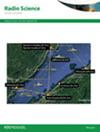Simulation-based channel modeling at 28 GHz for different vehicular traffic densities in vehicle-to-vehicle scenarios
IF 1.5
4区 地球科学
Q3 ASTRONOMY & ASTROPHYSICS
引用次数: 0
Abstract
Vehicle-to-Vehicle (V2V) communications have received a lot of attention as it can significantly improve efficiency and safety of road traffic. This paper introduces a novel data set, constructed at urban crossroads in different vehicular traffic densities (VTDs) for line-of-sight (LOS) and non-line-of-sight (NLOS) scenarios, utilizing Ray-tracing techniques for its development. Channel modeling was performed for the path loss, shadowing, and multipath characteristics of the propagation channel, that is, the root-mean-square delay spread, azimuth of arrival (AoA) spread and elevation of arrival (EoA) spread, correlations of spreads, and coherent distances of spreads of interest. The simulation results indicate that scenarios with low and medium VTD exhibit lower path loss and delay spread values compared to scenarios with high VTD. The AoA spread is significantly larger in the LOS scenarios compared to the NLOS scenarios, and the EoA spread demonstrates greater variations with different VTDs in both the LOS and the NLOS conditions. These results are important for generating realistic channel realizations for the design and performance evaluation of V2V communication algorithms in the context of the sixth-generation (6G) wireless networks.针对车对车场景中不同交通密度的28 GHz基于仿真的信道建模
车对车(V2V)通信由于能够显著提高道路交通的效率和安全性而受到广泛关注。本文介绍了一种新的数据集,在不同车辆交通密度(VTDs)的城市十字路口构建了视距(LOS)和非视距(NLOS)场景,并利用光线追踪技术进行了开发。对传播信道的路径损失、阴影和多径特性(即均方根延迟扩展、到达方位角(AoA)扩展和到达仰角(EoA)扩展、扩展的相关性和感兴趣扩展的相干距离)进行信道建模。仿真结果表明,与高VTD场景相比,低VTD和中等VTD场景表现出更低的路径损耗和延迟扩展值。在低空和非低空条件下,AoA的分布明显大于非低空,AoA的分布在不同vtd条件下的差异更大。这些结果对于第六代(6G)无线网络环境下V2V通信算法的设计和性能评估产生真实的信道实现非常重要。
本文章由计算机程序翻译,如有差异,请以英文原文为准。
求助全文
约1分钟内获得全文
求助全文
来源期刊

Radio Science
工程技术-地球化学与地球物理
CiteScore
3.30
自引率
12.50%
发文量
112
审稿时长
1 months
期刊介绍:
Radio Science (RDS) publishes original scientific contributions on radio-frequency electromagnetic-propagation and its applications. Contributions covering measurement, modelling, prediction and forecasting techniques pertinent to fields and waves - including antennas, signals and systems, the terrestrial and space environment and radio propagation problems in radio astronomy - are welcome. Contributions may address propagation through, interaction with, and remote sensing of structures, geophysical media, plasmas, and materials, as well as the application of radio frequency electromagnetic techniques to remote sensing of the Earth and other bodies in the solar system.
 求助内容:
求助内容: 应助结果提醒方式:
应助结果提醒方式:


